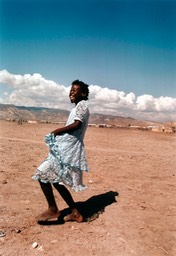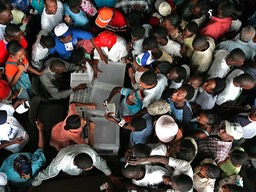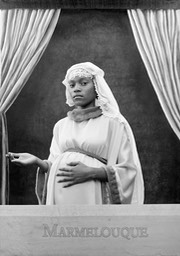Audio interviews with guest curator Edouard Duval-Carrie, assistant Maggie Steber museum director Bonnie Clearwater and artists Adler Guerrier and Carl Juste.
A new photography show in Fort Lauderdale takes a deeper look at Haiti
Everyone has seen the graphically tragic news photos of Haiti: horrific devastation from hurricanes and earthquakes; hunger and homelessness; ferocious political upheavals. For many outsiders, that’s what Haiti is — one disaster after another. With perhaps an “exotic” vodou ritual thrown in.
This tunnel vision excludes elements that Haiti’s own people — and a relative handful of outsiders — have come to know. And one that the organizers of the upcoming exhibition at the NSU Art Museum Fort Lauderdale plan to share.
From Within and Without: The History of Haitian Photography redresses that woefully inadequate picture, not by substituting a glamorized image but through a deep historically rooted comparison of how insiders and visitors represent the country and its people through photography.
Haiti’s photo documentation has been a longtime passion of Edouard Duval-Carrié, who guest-curated this exhibition, assisted by acclaimed photographer Maggie Steber, a former Miami Herald director of photography. Duval-Carrié is a highly recognized artist with extensive curatorial experience, especially with Caribbean-based exhibitions. His research has led him to several important — but little-exposed — collections of photography both within and outside Haiti. NSU Art Museum Fort Lauderdale director Bonnie Clearwater’s parallel interest converged with Duval-Carrié’s while she was curating an exhibition of Bruce Weber’s photography at the Museum of Contemporary Art in North Miami (MOCA) several years ago.
“Bruce Weber was using his techniques of a fashion photographer to seduce the viewer into caring about this issue of immigration,” she said in a recent interview. She learned that Duval-Carrié was organizing an exhibition that would focus on archival photography mostly by Haitian photographers, so when she assumed the directorship at NSU she was eager to host the show. She characterizes it as the first comprehensive museum survey of photography in Haiti. It incorporates approximately 300 images.
Duval-Carrié explained, “What we really wanted to do is give an overview of this general history and to finish with a group of Haitian photographers to see what their interest is and how they present themselves or what they capture about Haiti. And also, a group of photographers from everywhere else and how they cover Haiti. ... This exhibit floats, and the definition of photography oscillates between photojournalism to artistic presentation, so you will find artists that are totally abstract in their vision of things.”
Diverse views
With images spanning two centuries, and several mini-galleries featuring individual contemporary artists, the exhibition will do far more than scratch the surface or provide a nostalgic backward glance. Through extensive loans of 19th and early 20th century photographs, the roiling complexities of Haitian social, cultural and political history are closely recounted from various points of view.
And although it features considerable work from the early days both of the nation and of the emergence of the medium, the show assumes the modern curatorial view that photography is not objective. It used to be believed that painting, drawing and printmaking were interpretive processes, whereas photography was capturing reality. “But,” said Clearwater, “the realization, as time went on, was that who was making the photograph, how it’s cropped, how it’s printed, how it’s used affects the meaning. This exhibition specifically addresses those issues.”
For example, when photographer A. Hartmann created a set of daguerreotypes in 1849 to document the coronation of Haitian Emperor Faustin Soulouque, the images established an archetype of pomp and ceremonial elegance quickly adopted by newly opened photo studios and their wealthy clients. Ironically, as Duval-Carrié writes in a catalog essay, “The images of Soulouque’s coronation, intended to establish a visage of republicanism abroad, instead became symbolic of an infantilism and corruption tinted by European racism.” The free citizens of a nation liberated from slavery had mimicked the pageantry of their previous oppressors.
A wealth of such studio images, collected in Canada, is on display — sometimes reprised by later photographers. What this first generation of Haitian photographers did not capture was their own countryside and rural citizenry. That task — in its enormous variety — was achieved by scores of other photographers whose work conveys the complex history and social dynamics of Haiti in its full beauty and ugliness.
Vivid catalog
The exhibition is accompanied by a catalog of vivid essays and images, providing both scholarship and opinion. Steber’s essay examines reportage by the Miami Herald and Fort Lauderdale Sun Sentinel via interviews with five staff photographers, both Haitian and non-Haitian, whose poignant anecdotes and diverse opinions expose the complex issues of photojournalism. “Covering Haiti is a constant Shakespearean epic that bewilders and confuses journalists, who want quick and easy yes-or-no answers to preconceived notions already reported,” she wrote. But many journalists, she also notes, are compassionate people who do good — sometimes at great personal risk.
Steber’s own work encompasses President Jean-Bertrand Aristide’s inauguration, the corpse of a shooting victim, a grim trial scene, but also some joyous moments. As she composed an image in a dusty slum on the outskirts of Gonaives, she wrote, “into my frame comes this little girl laughing and singing and dancing in a torn blue lace dress, and it just reminded me that beauty is found in Haiti in the most unexpected places.”
Haitian-born Carl Juste, a Miami Herald photographer, has also organized exhibitions, bringing photojournalism into fine-art venues, as when he co-curated I Witness with Miami gallerist Bernice Steinbaum. Working within and outside daily newspaper photojournalism, he understands issues of scale, cropping, timing, intention and venue. He decries portrayal of Haitian people as hapless pawns. His late father, Viter Juste, who championed human rights both in Haiti and in Miami, instilled that ardent moral righteousness in his son. “I don’t see Haiti as spot news,” he told Steber. “My dad left me with a sense of justice, and I am not neutral. I believe with our photographs we give Haitians a megaphone to amplify their voice. We are not victims but victors.”
Destruction and death have been endemic in Haiti, but for Miami Herald photographer Patrick Farrell, who won a Pulitzer Prize for his 2008 Haiti hurricane coverage, photography can also bestow influence on its subjects, allowing them to impact the wider world. As Steber recorded, “A man grabbed my arm and asked me to take a photo as he held up the lifeless body of his daughter. Those images are seared into my brain. These are not my images; they belong to the people I photograph, and I want viewers to have empathy.”
Historical images
Deplorably, the United States largely ignored the creation of a democracy “in its backyard” during the early decades after Haiti’s revolutionary liberation from French rule. As Duval-Carrié put it, “For 60 years we couldn’t dream of dealing with a black nation!” As early as 1890, but especially in the lead-up to America’s occupation of Haiti (1915-1934), commercial and military surveillance interests led to extensive photographic documentation of Haiti’s infrastructure, geographic terrain, historical landmarks and village life inland from the coast.
Of course, not all such photographic documentation was benign. One controversial image was the photograph of Charlemagne Péralte, an organizer of resistance to the occupation. American military personnel assassinated him and, attempting to quell an uprising, widely disseminated a photo of his shirtless body, tied to a door. This misguided effort backfired, however, as “that photograph ends up creating this mythology of the martyred rebel,” said Clearwater, rather than serving as a warning to the Haitian people.
During the early to mid-20th century, ethnographic inquiry flourished. Such scholars and artists as Zora Neale Hurston, Langston Hughes, Katherine Dunham and Alan Lomax from the United States, alongside equally avid Europeans, enthusiastically recorded Haitian folk life, visual art and religious ceremonies. Once foreigners became interested in the country’s interior, so did Haitian photographers, encouraged by the lower cost of cameras. This helped democratize photography, leading to more diverse imagery — in and outside of studios.
Haiti’s African-based vodou tradition is grounded in the country’s topography and history. Sacred sites include waterfalls, mud pools, beaches, caves and cemeteries, where ceremonies are regularly held. The potency of vodou ritual has been subject to literary and graphic exploitation as well as serious study. Visitors will discover a wide range of photographic treatments, including arresting images by Chantal Regnault, Cristina García Rodero and Leah Gordon, who also created a portrait series that derides the long-standing practice of giving and withholding social standing according to skin color. Race and class status are also explored in Paolo Woods’ comic-caustic portraits.
Photographic artistry
A set of folksy, sentimental and sometimes bizarre composite portraits from the 1960s was collected by Chicago-based scholar Marilyn Houlberg. Some utilize low-tech overlay techniques to astonishing effect. Never intended for museum exhibition, they provide yet another novel expression of photographic artistry.
Experimentation continues with Roberto Stephenson, whose cityscapes include saturated, multi-layered, panoramic and skewed compositions, blurred with movement. He also captures the unspoiled beauties of Haiti’s diverse terrain, devoid of people and imbued with that timeless spirit that emerges from a fleeting confluence of conditions.
The desire to find and convey a sense of place continues on and off the island. Miami artist Adler Guerrier recently said, “Place is a construct that is placed upon space and geography, and it is as much politicized as it is culturally defined.” For this exhibition, he offers photographic images taken in Miami backyards that provide the “everyday luxury that most of us aim for,” where one can sip lemonade, listen to birdsongs and read a book.
Breaking with convention, Guerrier often eschews color in his representation of the tropics. His work is as much cerebral as sensual. “The greenness is given,” he said, “and color actually can keep us away from understanding texture, whereas black and white and grays reinforce that.” Miamians of Haitian ancestry, he noted, constitute a vital segment of the Diaspora, and thus an essential part of the cultural entity called Haiti — as do the writings of Edwidge Danticat and the sculptural chandeliers that Duval-Carrié will contribute to the exhibition.
Not every photograph presents a recognizable person, place or thing. Stephane Kenn de Balinthazy zooms in on rusted, crackled surfaces to extract abstract painterly compositions from corroded elements of the environment where nature and mankind collide. Numerous other photographers take the medium into both intimate and remote places. Art and architectural historian Alfredo Rivera spotlights their distinctive practices in his catalog essay.
Rich cultural heritage
During 30 years, covering everything from wars to fashion in 65 countries, Steber frequently returns to Haiti out of affection for the country and its people. Many would consider her an insider. Still, Steber feels a barrier to fully penetrating the nation’s mysteries. “No matter how dedicated we are to Haiti or how much we love Haiti or have spent time there, we foreigners — in my opinion — all we can really do is press our noses up against the pane of glass that separates us from Haiti.”
While the exhibition offers telling juxtapositions of work done by Haitians and outsiders, no simple or conclusive distinctions can be rendered. The exhibition will definitely provoke new appreciation among the uninitiated and affirm to Haitian Americans the vast richness of their cultural heritage that has been missing from too much coverage of their country. As Duval-Carrié writes, “I leave it to my brothers and sisters of Haiti to judge an exhibition of this sort, and to realize that memory cannot be erased, and should be confronted and claimed.”
Listen to audio commentaries: bitly.com/HaitiWithinWithout
IF YOU GO
What: ‘From Within and Without: The History of Haitian Photography’
When: June 21 through Oct. 4 with various collateral programming
Where: NSU Art Museum Fort Lauderdale; One E. Las Olas Blvd., Fort Lauderdale
Info: 954-525-5500; www.moafl.org/
http://bit.ly/Herald-HaitiWithinWithout


